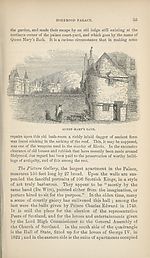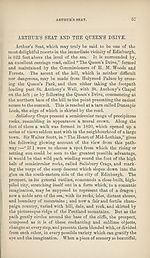Download files
Complete book:
Individual page:
Thumbnail gallery: Grid view | List view

56
EDINBURGH.
by Charles X. (of France) and his family in 1830-33. Her
present Majesty has rescued the Palace from the neglect into
which it had fallen, by making an occasional residence in it
during the summer.
The Abbey of Holyroodhouse, on the north side of the Palace,
was founded in 1128 by David I., a prince whose prodigal lib¬
erality to the clergy drew from James YI. the pithy observation
that he was “ a sair sanct for the Crown.” Of this building
nothing now remains but the mouldering ruins of the Chapel,
situated immediately behind the Palace. It was bestowed on
canons regular of St. Augustine, brought from St. Andrews,
and from them the “ Canongate ” took its name. “ It was fitted
up by Charles I. as a chapel royal, that it might serve as a
model of the English form of worship, which he was anxious
to introduce into Scotland. He was himself crowned in it in
1633. James II. (VII. of Scotland) afterwards rendered it
into a model of Roman Catholic worship, to equally little pur¬
pose. Since the fall of the roof in 1768, it has been a ruin.
In the south-east corner are deposited the remains of David II.,
James II., James V., and Magdalen his Queen, Henry Lord
Darnley, and other illustrious persons. The precincts of the
Abbey, as has been already stated, including Arthur’s Seat and
Salisbury Crags, are a sanctuary for insolvent debtors. The
limit of the privileged territory, on the side next the town,
extends to about a hundred yards from the Palace.
EDINBURGH.
by Charles X. (of France) and his family in 1830-33. Her
present Majesty has rescued the Palace from the neglect into
which it had fallen, by making an occasional residence in it
during the summer.
The Abbey of Holyroodhouse, on the north side of the Palace,
was founded in 1128 by David I., a prince whose prodigal lib¬
erality to the clergy drew from James YI. the pithy observation
that he was “ a sair sanct for the Crown.” Of this building
nothing now remains but the mouldering ruins of the Chapel,
situated immediately behind the Palace. It was bestowed on
canons regular of St. Augustine, brought from St. Andrews,
and from them the “ Canongate ” took its name. “ It was fitted
up by Charles I. as a chapel royal, that it might serve as a
model of the English form of worship, which he was anxious
to introduce into Scotland. He was himself crowned in it in
1633. James II. (VII. of Scotland) afterwards rendered it
into a model of Roman Catholic worship, to equally little pur¬
pose. Since the fall of the roof in 1768, it has been a ruin.
In the south-east corner are deposited the remains of David II.,
James II., James V., and Magdalen his Queen, Henry Lord
Darnley, and other illustrious persons. The precincts of the
Abbey, as has been already stated, including Arthur’s Seat and
Salisbury Crags, are a sanctuary for insolvent debtors. The
limit of the privileged territory, on the side next the town,
extends to about a hundred yards from the Palace.
Set display mode to:
![]() Universal Viewer |
Universal Viewer | ![]() Mirador |
Large image | Transcription
Mirador |
Large image | Transcription
| Antiquarian books of Scotland > Scotland/Scots > Black's picturesque tourist of Scotland > (108) |
|---|
| Permanent URL | https://digital.nls.uk/130029486 |
|---|
| Description | Thousands of printed books from the Antiquarian Books of Scotland collection which dates from 1641 to the 1980s. The collection consists of 14,800 books which were published in Scotland or have a Scottish connection, e.g. through the author, printer or owner. Subjects covered include sport, education, diseases, adventure, occupations, Jacobites, politics and religion. Among the 29 languages represented are English, Gaelic, Italian, French, Russian and Swedish. |
|---|

